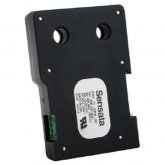Maast
Compulsive Tinkerer
Turns out NEC 2014 and on code requires PV installations to have arc fault interrupts on the incoming PV DC and unlike the normal Classic 250s these dont have AFCI in them.
After a bit of a panic and a few intimate hours with google I found that there is a 3rd party DC AFCI solution, the Sensata PVAF-T, it mounts on a din rail and is UL listed. It can monitor two separate lines theough the holes in it and is good up to 1000v DC and 40A. It also requires a external power supply and a contactor but that part is easy. Best of all I found them on ebay for 20 bucks. The only other one I found was $175 by dcsunvolt.

After a bit of a panic and a few intimate hours with google I found that there is a 3rd party DC AFCI solution, the Sensata PVAF-T, it mounts on a din rail and is UL listed. It can monitor two separate lines theough the holes in it and is good up to 1000v DC and 40A. It also requires a external power supply and a contactor but that part is easy. Best of all I found them on ebay for 20 bucks. The only other one I found was $175 by dcsunvolt.



